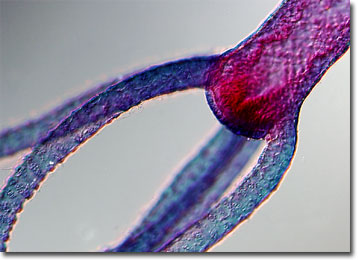Differential Interference Contrast Image Gallery
Stained Hydra
One of the most terrible mythological monsters of ancient Greece, the Hydra was a gigantic multi-headed sea serpent with poisonous breath. The second task of Hercules was to kill this dreaded beast, which had the power to regenerate two new heads whenever one was severed from its body.

Though not monsters by any means, the small freshwater creatures that belong to the class Hydrozoa and are commonly referred to as hydra in modern times do have several characteristics in common with their fearful namesake. Hydras feature numerous tentacles that bear poisonous nematocysts on their stalk-like bodies. The stinging cells enable the polyps to paralyze or kill prey and, since their bodies are flexible, they may consume creatures much larger than themselves. Furthermore, hydras have the power of regeneration. Even if one is completely severed in half longitudinally, it is possible for two genetically identical hydras to grow in its place. Small clones of a single parent hydra may also form through the asexual process of budding.
Often hermaphroditic, hydras may alternatively produce offspring sexually. Eggs and sperm are stored in separate swellings in the outer body layer of individual hydras. Fertilization occurs in the water after gametes of opposing sexes are released by two different hydras. The young embryos then attach to the hydra from which the eggs were donated and stay there until their mouths and tentacles develop. Subsequently, the new hydras break away from their mother to carry out the rest of their lives autonomously. Hydras generated in this manner tend to be better suited to surviving harsh environmental conditions than their asexually produced brethren.
